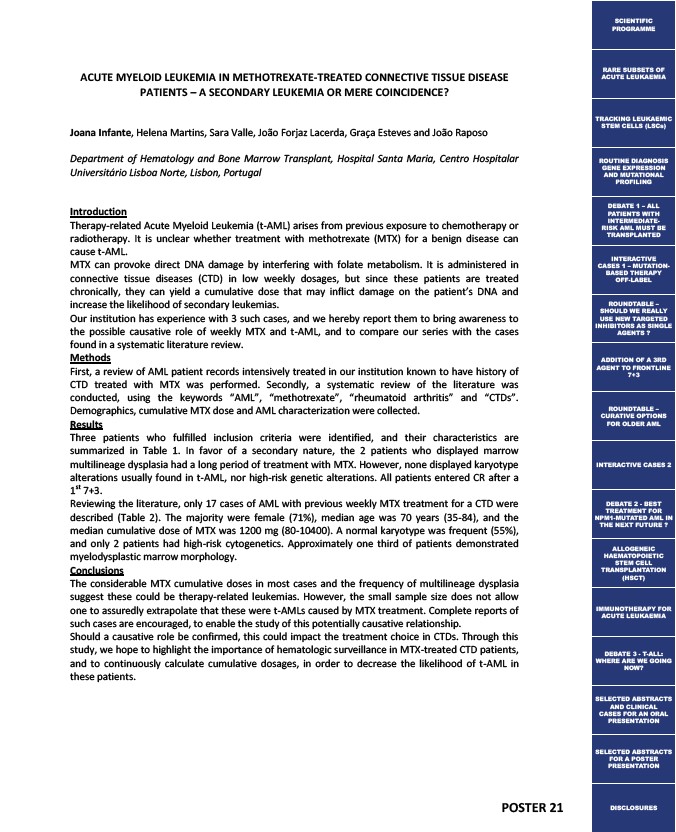
ACUTE MYELOID LEUKEMIA IN METHOTREXATE-TREATED CONNECTIVE TISSUE DISEASE
POSTER 21
PATIENTS – A SECONDARY LEUKEMIA OR MERE COINCIDENCE?
Joana Infante, Helena Martins, Sara Valle, João Forjaz Lacerda, Graça Esteves and João Raposo
Department of Hematology and Bone Marrow Transplant, Hospital Santa Maria, Centro Hospitalar
Universitário Lisboa Norte, Lisbon, Portugal
Introduction
Therapy-related Acute Myeloid Leukemia (t-AML) arises from previous exposure to chemotherapy or
radiotherapy. It is unclear whether treatment with methotrexate (MTX) for a benign disease can
cause t-AML.
MTX can provoke direct DNA damage by interfering with folate metabolism. It is administered in
connective tissue diseases (CTD) in low weekly dosages, but since these patients are treated
chronically, they can yield a cumulative dose that may inflict damage on the patient’s DNA and
increase the likelihood of secondary leukemias.
Our institution has experience with 3 such cases, and we hereby report them to bring awareness to
the possible causative role of weekly MTX and t-AML, and to compare our series with the cases
found in a systematic literature review.
Methods
First, a review of AML patient records intensively treated in our institution known to have history of
CTD treated with MTX was performed. Secondly, a systematic review of the literature was
conducted, using the keywords “AML”, “methotrexate”, “rheumatoid arthritis” and “CTDs”.
Demographics, cumulative MTX dose and AML characterization were collected.
Results
Three patients who fulfilled inclusion criteria were identified, and their characteristics are
summarized in Table 1. In favor of a secondary nature, the 2 patients who displayed marrow
multilineage dysplasia had a long period of treatment with MTX. However, none displayed karyotype
alterations usually found in t-AML, nor high-risk genetic alterations. All patients entered CR after a
1st 7+3.
Reviewing the literature, only 17 cases of AML with previous weekly MTX treatment for a CTD were
described (Table 2). The majority were female (71%), median age was 70 years (35-84), and the
median cumulative dose of MTX was 1200 mg (80-10400). A normal karyotype was frequent (55%),
and only 2 patients had high-risk cytogenetics. Approximately one third of patients demonstrated
myelodysplastic marrow morphology.
Conclusions
The considerable MTX cumulative doses in most cases and the frequency of multilineage dysplasia
suggest these could be therapy-related leukemias. However, the small sample size does not allow
one to assuredly extrapolate that these were t-AMLs caused by MTX treatment. Complete reports of
such cases are encouraged, to enable the study of this potentially causative relationship.
Should a causative role be confirmed, this could impact the treatment choice in CTDs. Through this
study, we hope to highlight the importance of hematologic surveillance in MTX-treated CTD patients,
and to continuously calculate cumulative dosages, in order to decrease the likelihood of t-AML in
these patients.
SCIENTIFIC
PROGRAMME
RARE SUBSETS OF
ACUTE LEUKAEMIA
TRACKING LEUKAEMIC
STEM CELLS (LSCs)
ROUTINE DIAGNOSIS
GENE EXPRESSION
AND MUTATIONAL
PROFILING
DEBATE 1 – ALL
PATIENTS WITH
INTERMEDIATE-RISK
AML MUST BE
TRANSPLANTED
INTERACTIVE
CASES 1 – MUTATION-BASED
THERAPY
OFF-LABEL
ROUNDTABLE –
SHOULD WE REALLY
USE NEW TARGETED
INHIBITORS AS SINGLE
AGENTS ?
ADDITION OF A 3RD
AGENT TO FRONTLINE
7+3
ROUNDTABLE –
CURATIVE OPTIONS
FOR OLDER AML
INTERACTIVE CASES 2
DEBATE 2 - BEST
TREATMENT FOR
NPM1-MUTATED AML IN
THE NEXT FUTURE ?
ALLOGENEIC
HAEMATOPOIETIC
STEM CELL
TRANSPLANTATION
(HSCT)
IMMUNOTHERAPY FOR
ACUTE LEUKAEMIA
DEBATE 3 - T-ALL:
WHERE ARE WE GOING
NOW?
SELECTED ABSTRACTS
AND CLINICAL
CASES FOR AN ORAL
PRESENTATION
SELECTED ABSTRACTS
FOR A POSTER
PRESENTATION
DISCLOSURES